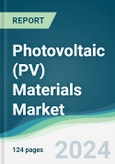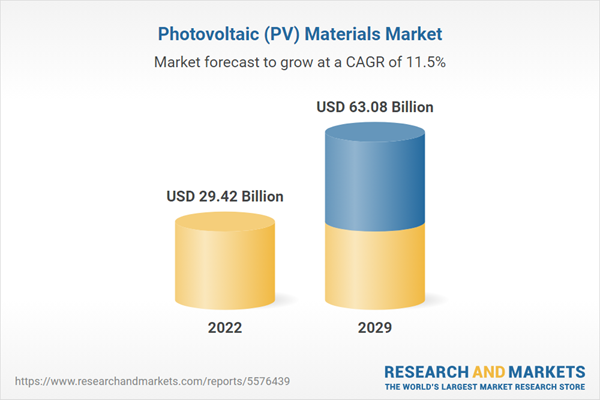The photovoltaic (PV) materials market is evaluated at US$29.418 billion for the year 2022 growing at a CAGR of 11.51% reaching the market size of US$63.075 billion by the year 2029.
Solar energy can be converted directly into electricity by photovoltaic materials made up of semiconductor material. Photovoltaics have arisen as an incredible renewable energy source and a viable substitute for fossil fuels in recent years. Furthermore, growing environmental concerns such as climate change and global warming are propelling the growth of solar and wind energy. Solar energy's sustainability and unlimited potential, coupled with technological advancements, make it a sustainable and viable energy source to meet our growing energy demands in the future. Also, recent advances in raw materials and technology have spurred the solar industry, driving up interest in photovoltaic materials.The photovoltaic materials market is mainly driven by the increasing focus on cleaner energy technologies. Furthermore, a stringent government policy against fossil fuel emissions as well as encouraging government policies to boost renewable energy is encouraging an increase in PV material demand. Solar energy has unlimited growth potential, and continuous technological advancements will foster growth in the industry. Currently, almost 12,000 large-scale solar projects are listed, generating more than 166 GW of energy in the United States. To support smart renewable energy and grid modernization projects, the Government of Canada has launched a $964 million program in 2021.
MARKET DRIVERS:
Increasing use of solar PVs.
By 2050, solar PV will be the world's second-largest power source, behind wind power, and will revolutionize the world's electricity sector. Globally, solar PV will produce a quarter of the world’s electricity needs (25% by 2050), making it an important source in the future. Over the next ten years, solar PV capacity is expected to increase almost sixfold, peaking at 480 GW in 2018 and falling to 2 840 GW by 2030, followed by 8 519 GW by 2050 - or almost 18 times the amount produced in 2018. In 2050, solar PV power will be dominant in Asia (mostly China), with more than 50% of the global installed capacity, followed by North America (20%) and Europe (10%). Renewable technologies such as solar PV have been pioneered, over the centuries.Supportive government policies and initiatives.
Various governments around the world are constantly formulating policies to make grid connections convenient for photovoltaic projects. Chinese, Canadian, American, and French companies are encouraging the use of solar energy. The PV material market is expected to grow due to initiatives and government policies in the forecast period. According to the Institute for Energy Economics and Financial Analysis (IEEFA) of the University of California, Irvine, India has five of the world's top 10 upcoming solar projects.Further, China accounted for 32% of the world's total investments, trailed by Europe at 21%, the United States at 17%, and Asia-Pacific (other than China and India) at 15 %. The Middle East and Africa had a 5% share of the smaller regions, the Americas (excluding the United States) had a 3% share, and Brazil had a 1% share. (Source: unep.org). PV cells are being used by private companies in the region to boost their efficiency. The Dutch construction company Vorm, for instance, is building a solar module factory with 300 MW of capacity. In Denmark, the Spanish energy firm Powertis SA is planning to develop more than 150 MW of solar photovoltaic (PV) projects. Therefore, numerous solar power projects are being planned and built, that are expected to positively influence the photovoltaic materials market outlook.
MARKET RESTRAINTS
Lack of highly skilled professionals.
There is a great diversity of professional roles within photovoltaic installations, ranging from R & D scientists working at Ph.D. levels to technicians who must be fully certified and trained to a host of other professionals who support all aspects of the industry. This new technology cannot be implemented in the industry without enough experienced installers. In the PV sector, one of the most prominent challenges has been finding appropriately skilled labor. While the technology is being developed, the end-users need acknowledged standards, quality assurance, and skills certification throughout the development process.The North American photovoltaic (PV) materials market is anticipated to grow significantly.
Several important reasons that are driving the expansion of the solar energy industry are driving the photovoltaic (PV) materials market in North America. One of the main drivers is the growing focus on renewable energy sources, which is accompanied by policies and incentives from the government encouraging the use of solar power. The industry is being pushed by an increasing need for carbon neutrality and sustainable energy solutions due to environmental concerns. Furthermore, the market is growing due to improvements in PV technology and a decline in the cost of solar components, which increases the economic viability of solar energy.Key Developments:
- In March 2023, to support the worldwide shift towards renewable energy, Dow announced the extension of its silicone sealant products to include photovoltaic (PV) module assembly components. To provide longevity and tested performance for frame sealing, rail bonding, junction box bonding and potting, and building integrated photovoltaics (BIPV) installation materials, the recently introduced DOWSILTM PV Product Line, which includes six silicone-based sealants and adhesives solutions, may be utilized.
- In January 2023, Avient Corporation announced the introduction of novel cross-linkable formulations for photovoltaic cables in solar energy applications that enable sustainability.
Segmentation:
By Material Type
- Monocrystalline Silicon
- Polycrystalline Silicon
- Amorphous Silicon
- Gallium Arsenide
- Cadmium Telluride
- Others
By Application
- Residential
- Commercial
- Industrial
By Geography
- North America
- USA
- Canada
- Mexico
- South America
- Brazil
- Others
- Europe
- United Kingdom
- Germany
- France
- Others
- Middle East and Africa
- Saudi Arabia
- Israel
- UAE
- Others
- Asia Pacific
- China
- Japan
- India
- South Korea
- Others
Table of Contents
Companies Mentioned
- Targray
- Topsil GlobalWafers A/S
- DuPont
- Wacker Chemie AG
- Shin-Etsu Chemical Co., Ltd.
- Gelest Inc.
- Avient
- Energy Materials Corporation
- GCL Technology Holdings Limited
Table Information
| Report Attribute | Details |
|---|---|
| No. of Pages | 124 |
| Published | February 2024 |
| Forecast Period | 2022 - 2029 |
| Estimated Market Value ( USD | $ 29.42 Billion |
| Forecasted Market Value ( USD | $ 63.08 Billion |
| Compound Annual Growth Rate | 11.5% |
| Regions Covered | Global |
| No. of Companies Mentioned | 9 |









